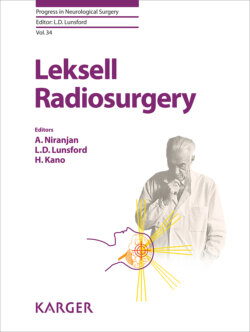Читать книгу Leksell Radiosurgery - Группа авторов - Страница 40
На сайте Литреса книга снята с продажи.
Frame-Based Stereotactic Radiosurgery Procedures
ОглавлениеAt UPMC-Presbyterian Hospital, frame-based procedures continue to be used in most patients who are thought to be excellent brain Leksell radiosurgical cases. This includes all patients with arteriovenous malformations, skull base tumors, and functional procedures such as trigeminal and thalamic radiosurgery. Because of the extensive experience with over 30 years and more than 15,000 patients, the frame-based technique provides known superior accuracy, reliability, and firm fixation while also allowing administration of conscious sedation medication intravenously in patients with any level of mild to moderate anxiety. Frame-based techniques are also preferred in those rare pediatric or adult cases that require general anesthesia. Currently, only frame-based procedures are possible in arteriovenous malformation procedures during which digital subtraction angiography is used to supplement targeting. No DSA adapter is available for mask fixation. Frame-based techniques are particularly important in patients whose beam on time will exceed 30 min, in those with multiple targets, and in those whose targets are inferior or far posterior or anterior in the cranial vault. Patients with any level of anxiety for whom some form of oral or intravenous sedation is thought necessary are poor candidates for frameless Leksell radiosurgery. Patients who receive sedation and fall asleep or become confused lead to motion that is easily detected by the ICON patient motion management system. This then leads to retraction of the beams followed shortly thereafter by removal of the patient from the ICON. Reinstitution of radiation requires another CBCT, a process that takes a minimum of 10–15 min each time to obtain, co-register, confirm, and restart.
The patient flow of a frame-based procedure starts with patient selection and preparation by our team. On the morning of the scheduled procedure patients arrive at 05:30 and receive a 1-mg sublingual dose of lorazepam. An IV is placed to add conscious sedation using titrated doses of midazolam and fentanyl in order to secure a relaxed patient. The vital signs are monitored, including blood pressure, pulse oximetry, and heart rate. Patients rest comfortably in a semi-sitting position on a hospital gurney that allows both Trendelenburg and reverse Trendelenburg positions in the unusual event of blood pressure changes. Women are more likely to have some hypertension while men are more susceptible to vasovagal events that may require increased IV fluids, a feet up position, or even administration of atropine sulfate IV. We frequently use a small application of 5% EMLA cream to the frontal and occipital regions to reduce discomfort at the time of local anesthesia injection for frame placement. Once the patient is prepared for frame application, the head is prepped with alcohol. We prefer to have one team member on each side of the head so that contralateral pins can be anchored together. The pin height is selected based on any history of prior surgery, craniotomies, or burr holes that should be avoided during pin placement. The Leksell frame is attached to the head with a base ring lowered to about C2 using the ear bars set at a Y of 95. Frame shifting in the left-right direction is almost never needed unless it is necessary to allow for adequate pin purchase on the cranial vault.
Once the frame is attached, a check of the frame cap, the Perfexion or ICON adapter, and the head configuration bubble measurements are made. The patient is then transferred by stretcher to the imaging site, usually MRI. For patients unsuitable for MRI, CT scans are obtained. For arteriovenous malformation patients, we also include DSA studies which are reviewed at the time of the angiogram, after which selected views are electronically transmitted to the dose planning system. The standard workflow for frame-based procedures is shown in Figure 1.
Fig. 1. All the components of frame-based SRS are completed in a single day. Frame-based radiosurgery starts with the placement of the Leksell head ring under local anesthetic and mild conscious sedation. Stereotactic imaging is conducted next and the images are exported to Gamma-Plan workstations where dose planning is performed. Once planning is complete and approved, the treatment (radiation delivery) begins (courtesy of AB Elekta).
After dose planning is completed and exported to the appropriate Gamma Knife, the patient is brought into the room and positioned on the table using the frame attachment to the bed. When patient verification, plan confirmation, and patient fixation is complete, personnel leave the room and the treatment team starts the procedure. For patients with residual anxiety or for those whose beam on time may be longer – for example patients with more than 10 brain metastases – additional conscious sedation is administered to insure patient relaxation and comfort. Many patients drift off to sleep. Frame fixation prevents any movement of the target in stereotactic space.
